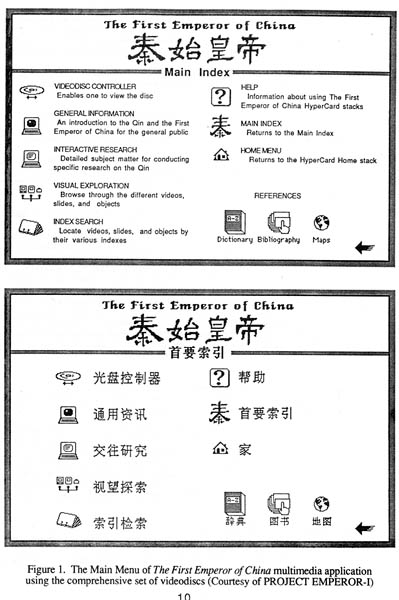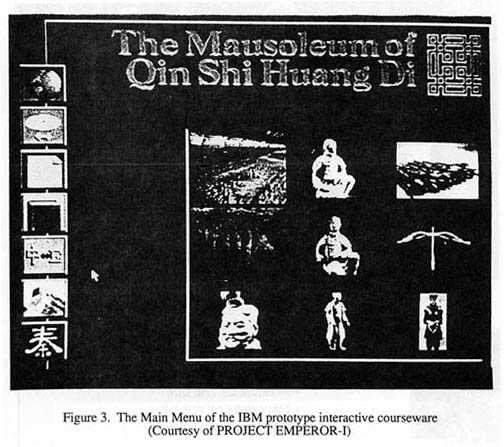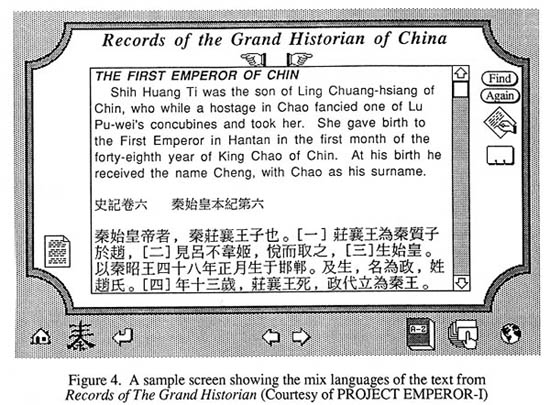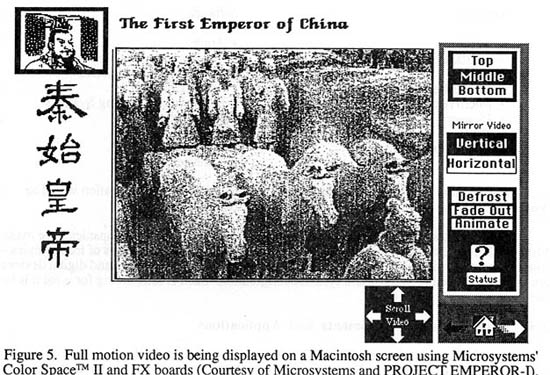


Ching-chih Chen
Graduate School of Library & Information Science
Simmons College
Boston, MA 02115, USA
Abstracts: A brief overview on the recent technological development in the area of multimedia technologies to enhance information access. Topics covered will include analog videodisc, digital technologies and their interactive applications, and the current media-mixed information provision environment. As an illustration to the technological development discussed, an update the recent development of the 6-year R&D project, PROJECT EMPEROR-I, will be given. Implications of these technologies in enhancing information access and provision will be discussed.
In the previous decade, delivery of multimedia information was only possible in a limited way. Most computer information systems were almost exclusively textual and numeric in nature. With the introduction of microcomputers and its increasing computing power and information management functionalities, we witnessed the revival of videodisc technology, which was limited almost only to recreation prior to the beginning of 1980s. The marriage of microcomputers and videodiscs presented the information professionals with exciting opportunities for information provision. In addition, the increasingly powerful microcom-puters coupled with videodisc's large multimedia storage capacity and its fast and random retrieval power of multimedia information, have prompted the use of interactive videodiscs for various serious education, training, and marketing applications. Although digital videodisc was available in the earlier years as well, analog videodisc applications were much more popular. In other words, most interactive applications were developed with videodiscs which store images and videos in analog format with 54,000 frames available on one side of a videodisc. Interactive videodisc courseware were developed using analog videodiscs together with an array of computers, mostly microcomputers. In mid 1980s, Digital Equipment Cor-poration (DEC) first introduced its IVIS (Interactive Videodisc Information System). Although IVIS was abandoned by DEC a couple of years later, we have witnessed the introduction of an array of interactive videodisc applications developed on various delivery platforms, such as IBM PC, Macintosh, and proprietary microcomputer-based systems, such as that for the BBC's Dome's Day project. The early interactive videodisc applications generally required substantially more labor-intensive programmings. Since few could be developed by those without sophisticated programming capability, they could not achieve widespread use and appreciation.
Somewhat parallel to the development of interactive videodisc applications , we have witnessed a striking development in the last fifteen years in the area of hypertext and multi-media/hypermedia technology applications. Chen (June 1989b, December 1989) describes the development of hypertext and then hypermedia applications with the major milestones starting with Vanevar Bush's initial concept of "non-sequential linking of ideals" in 1945. Although the concept was not new, the word "hypertext" is only about 15 year old, as it was coined by Ted Nelson in the first half of 1970s. Various experiments on the development of hypertext applications and systems took place in the following decade, followed by the introduction of a few commercial products and tools, such as Guide by Owl. Yet, it is generally accepted that the hypermedia and multimedia applications have exploded only since Apple introduced its incredibly cheap but powerful HyperCard™ in the last quarter of 1987. HyperCard™ has been so popular because of its ease of use, flexibility and diversity in creating hypertext and hypermedia applications by those who are not necessarily computer programming sophisti-cated. Furthermore, its widespread availability and low cost (free to every new Macintosh owner and less then $30 to the existing Apple users) are additional attractions.
2. MULTIMEDIA TECHNOLOGIES AND DIGITAL APPLICATIONS
Since the introduction of HyperCard™, each year has been considered as one of the most significant years for the development of multimedia technologies. There have been so many significant advances related to various components of multimedia technologies -- computer processing, image processing, optical storage technologies, display technologies, digital audio, consumer electronics, telecommunications, scanning, digitized video techno-logies, desk-top video technology, etc. All have contributed greatly to the development of multimedia applications. In just the most recent two years, the fast growing number of conferences and exhibitions devoted to multimedia technologies and their applications and the extensive coverage of these topics in both popular and professional literature attest to their popularity. Thus, in addition to interactive videodisc applications, a number of acronyms
have been added to multimedia's vocabularies. These include:
• CD-ROM XA (eXtended Architecture),
• CD-I (Compact Disc-Interactive),
• DVI (Digital Video Interactive),
• CD-TV,
• Photo CD.
Clearly, we have entered the digital environment, and the multimedia applications heavily utilized information sources in digital form. They integrate multimedia information sources -- video, sound, music, and voice in a way which differs from interactive videodisc applications.
For centuries, we have been conditioned to access information mainly through printed sources. Because non-print information sources could not be readily available to us, we have trained ourselves either not to seek or to offer information available in those formats. Now, with text, picture, sound, and moving image all available in digital form, we clearly see the fading electronic boundaries among them. Once information is being presented in digital format, both the applications developers and users can retrieve the needed information easily, can cut-and-paste as they wish, and can also manipulate it in whatever way they see fit. Taking image as an example, an analog image can only be presented in its entirety as one frame of picture, while a digital image can be stored as a file and retrieved as such as well. Depending on the resolution and scale it is stored in in digital format, it presents its users endless possi-bilities for processing in any way relevant to the users' need, such as zoom in, zoom out, flipping horizontally or vertically, "fat-bit" in looking at each individual pixel, etc... In addition to the examples offered in this paper, further illustrations can be found in Martinez' presentation.
Presently, information technologies have developed to such an extent that we have almost all the necessary tools to enable us to organize, store, retrieve, and access needed multimedia information sources almost instantly. Many of these technological tools are very affordable -- yes, even for developing countries! The widespread use of these technologies will undoubted-ly have substantial impact on the way knowledge will be recorded, disseminated, utilized, and consumed in this new visual information age. Thus, a serious reevaluation on our conven-tional ways of information handling, organization, and provision is needed
3. TECHNOLOGY vs CONTENT
In my speakings and publications throughout the years, I have repeatedly stressed that technology is only a tool (Chen, 1987). It is a very effective means to an end, but not the end itself. What is most significant is the "content." In other words, conceptually how knowledge of a given subject is being structured, and what and how it can be presented to the end-users via the use of the present multimedia technological tools is the most important question. At this conference, this is stressed by several speakers as well, such as Chickering, Hauge, Henriksen, and Penniman.
As we all know, the basic concept of multimedia information access refers to the non-linear and no-sequential ways of accessing information. In other words, an information seeker does not have to follow a specific sequential path to request and/or locate information. Yet, this does not mean that information will be presented in "chaotic" state. In fact, we need to have so much more information organization in order to be able to provide the kind of flexi-bility so prominently characterized by only "good" multimedia applications. In other words, the developer of a good multimedia information system has to be able to, behind the applica-tion, structure so clearly the entire knowledge domain of a chosen topic and provide so many necessary links to those related ideas, concepts, and topics, that the information seekers are permitted to ask for needed information non-sequentially, and without following any pre-determined and pre-structured path.
4. MULTIMEDIA AND RECENT DEVELOPMENT IN DIGITAL COMMUNI- CATIONS
Aside from the dynamic growth of multimedia computing technologies, it is important to take serious note of the recent development in communications and networking. As you all know, this series of non-profit conferences started with the First Pacific Conference on New Information Technology in Bangkok in June 1987. The Proceedings of that conference was prepared with camera-ready copy of authors' manuscripts. In 1989, the Second Pacific Conference on New Information Technology in Singapore was held in May 1989. Thanks to the telephone communications, we were able to produce a very attractive Proceedings in less then two weeks by heavily utilizing fax technology and desk-top publishing. For this con-ference, e-mail has been heavily used to transmit files of authors' articles, and to communicate among ourselves. Several Eastern European authors used BITNET and INTERNET to transmit information digitally. Without these digital communication networks and the fax machines, it would have been impossible to organize a conference such as NIT '91.
Now, digital electronics have prompted the convergence of the historically separate modes of communication. This convergence of the modes of delivery -- print, common carriage, and broadcasting -- is bringing conventional information sources, such as books, magazine, journals, and newspapers; as well as those others -- music, images, motion video, numerical data, and computer programs, to the threshold of digital electronic communication With the advent of digital communication network, multimedia information not only can all be created, collected, organized, reorganized, copied, displayed or performed, but also can be distributed and shared globally through high-speed communication networks. Again, since technology is either here or will be ready soon, we should ask again "what are the contents, in multimedia format, which can benefit the end-users through the use of the available digital network? And who is going to create these contents and make them available?"
Time and space limitations do not permit further elaboration on the above discussions. Instead, a brief update on some of the very recent developments of the 6-year R&D project, PROJECT EMPEROR-I, will help to illustrate both the recent technological development and the potentials of current multimedia applications in the digital environment.
5. PROJECT EMPEROR-I'S NEW DEVELOPMENT & APPLICATIONS
5.1. Background
PROJECT EMPEROR-I, supported by the US National Endowment for the Humanities, started in late 1984 as an interactive videodisc project. Since then, because of the technological development, it has become a rather extensive multimedia application project with more than 60-hour interactive courseware running on Apple's Macintosh, and also various prototype applications running on a great variety of delivery platforms, such as DEC's MicroVax and IBM PC. It has since been covered in over 15 countries public media, featured on over two dozen international conferences, and a large number (over 70) of professional and general-interest publications.1 Readers are also referred to specifically two key articles in Academic Computing (Chen, March 1989) and Microcomputers for Information Management (Chen, June 1989) for general overviews as well as discussions on the conceptual framework of the project. A few additional sample sources are also included in the Reference Section (Chen, 1988; 1990).
5.2. Project Activities
Since 1985, the project has grown rapidly. The major products and activities thus far include the following:
• The production of a set of two 12" NTSC CAV videodiscs, entitled "The First
Emperor of China: Qin Shi Huang Di, " in 1985;
• Publishing a popular version of an one-sided videodisc by The Voyager Company also entitled The First Emperor of China. In conjunction with this analog videodisc, a detailed guide book with extensive subject index and frame-by-frame index has been prepared. Current effort is being directed to develop jointly with the Voyager Company a popular version of interactive software running on both Macintosh and IBM PC together with the videodisc.
• Multimedia application development - The development of interactive courseware, which consists of a general information level for the lay public, and an interactive research level for serious students and researchers. Developments in this area include:
- Prototype courses for Digital Equipment Corporation’s IVIS system during 1985-87;
- Early sample courses for IBM compatible PC systems using AimTech’s IconAuthor;
- Using HyperTalk to develop interactive courses running on Apple's Macs (both comprehensive and the Voyager versions as discussed above). The earlier Chinese version of the hypermedia courses for Macintosh is developed with Apple’s ChineseTalk. (See Chen, March 1989 for more discussion on courses for Macintosh);
- Prototype multimedia course development on DEC-MicroVax with MIT's Project Athena
- Currently, efforts are directed to the continuing of the multi-year efforts in the development of extensive multimedia courseware (more than 60 hours) for both general and scholarly audience, running on Macintosh. Figure 1 shows the menu of the comprehensive version, and
Figure 2 is the preliminary version of the menu for the Voyager version of the videodisc.
In the case of the comprehensive version, the courseware are used together with the compre-hensive set of 4-side videodiscs, The First Emperor of China. Within this multimedia application, system users can access to multimedia information on any related topics -- video segments, images, descriptive information, texts, bibliographies, maps, glossaries, commen-taries by experts, etc... -- at a simple click of the mouse. In addition, an image database of over 2,000 selected images, with extensive frame-to-frame database and descriptive infor-mation, has been built; and capabilities to access selective multi-lingual texts in both English and Chinese have also been provided. These have been developed in the HyperCard environment.
- While the most complete multimedia system in available on Macintosh, prototype develop-ment on IBM using Linkway™ and IBM's M-Motion card has yielded very interesting results (Chen, 1991). Figure 3 shows one the menu screen from IBM application.
• Electronic Image Databases - Prior to 1988, efforts were directed in experimenting the creation of electronic image databases for IBM compatibles using Image Concepts' C-Quest, and for Apple’s Mac IIs using Hypertalk. Since then, extensive image database of over 2,000 images has been developed on Mac in the HyperCard environment. Joint research activities also took place with University of Nice and Sophiatec in France. Current joint research activities include one with DOCIM supported by the Swedish Council of Library
Research, and exploration of possible cooperative activities in the use of visual language to retrieve images;
• High-resolution image digitization and electronic imaging
- On Sun Microsystems’ Sun 3-160 with Image Understanding System’s OASIS software;
- Digital images using MicroTek color slide scanner;
- With the cooperation of Kodak, an Initial Test Format Disc of the Kodak's Photo-CD was created.



• Converting and creating large textual files with images and Chinese characters by using MicroTek’s MSF-300G image scanner and INOVATIC’s optical character recognition soft-ware, ReadStar II Plus. In addition, using Xanatech's Mishu™, we have been successful in finding ways to include mixed English-Chinese languages on the same HyperCard in the word-processing mode. Figure 4 shows a sample text of the Chinese classic, Records of the Grand Historian with its English translation. In order to store these large files, currently a CD-ROM is being pressed.
5.3. Industrial Cooperation
PROJECT EMPEROR-I has been fortunate to be able to
work with a number of leading high-tech companies. These include:

Hardware Software
• Apple • Apple
• Digital Equipment Corporation • AimTech Corporation
• IBM • ASYS Computer System
• Mass Microsystems • Image Concept, Inc.
• MicroTek Lab • Image Understanding Systems • Pioneer • Kodak
• Sony • INOVATIC
• Sun MicroSystems • SOPIATEC
• Xanatech, Inc.
In addition to the above, the electronic publishing involves the cooperation with The Voyager Company and the Disc Manufacturing, Inc. (DMI).
Cooperation and hardware/software support from these industrial companies have made PROJECT EMPEROR-I an technology integration project in which all types of technologies -- microcomputer, videodisc, CD-ROM, WORM, removable drive, scanning and digital devices are integrated together in the entire system configuration. Each is functioning for what it is best for.
5.4. Most Recent Developments and Applications
In the last couple of years, PROJECT EMPEROR-I has benefited a great deal by the advent of digital technologies. New activities since the second half of 1990 have shifted considerably to the digital domain, although considerable efforts have continued to be made in content building for multimedia courseware development. The experiment in the digital domain has been related to the following areas, such as the use of high-end video digitizing boards for full motion video, color image scanning and processing, and the use of Kodak Photo CD Acquire test software, etc... The following describes these activities:
• While the lower-end multimedia application on Macintosh has to utilize two monitor screens -- one for the Mac, and one to display the RGB video from the analog videodisc, recent experiments have been conducted in providing real-time full-motion video with the help of high-end video boards. As stated above, the IBM prototype, developed in the summer of 1990, has to use M-Motion card with its Linkway™ software in order to show full motion video, while on the Mac system, Microsystems' Color Space™ II and FX boards (courtesy of Micro Systems) have been used since the summer of 1990. With these boards, the full-motion video coming from the analog videodisc can be displayed instantly in a digital way, thus enabling the presentation of grabbed video in whatever way in which the application is best suited, such as freezing a specific frame, scroll video, mirror video (as shown in Figure 5), or drag, flip, split field video, or even creating movie loops, as shown in Figure 6. These faci-lities have increased greatly opportunities for various information organization and presentation possibilities.
• Following the project's digital imaging activity in using Sun 3-160 Minicomputers, with which a number of very high resolution images (at 4Kx4K or 1Kx1K) were processed.
Since October 1991, with the availability of the Microtek color slide digitizer, Model 1850S,
and Microtek flat-bed color digitizer, Model MRS 600ZS, (courtesy of Microtek), experiments are being performed in digitizing color images at various resolutions and scalings. The Micro-tek's color slide digitizer can be accessed via a sophisticated image processing software,
PhotoShop™ 2.0. The scanner is capable of digitizing an image from any color slide at vary-ing resolution, ranging from 75 dpi to 600 dpi, and scaling, ranging from 12% to 100% for


600 dpi. The digitized images can then be processed by using sophisticated software, such as
PhotoShop™ 2.0. Images do consume computer storage space very quickly, thus the decision of both resolution and scaling is essential. For example, Figure 7 shows that at 240 dpi re-solution and 30% scaling, the image size is only 310 KB, while an image at 100 scaling and 600 dpi will need 19,923 KB, a very substantial increase in the consumption of storage space indeed! Although the project's work in color image scanning is very new, but there are already interesting results.
• With the cooperation and courtesy of Kodak, an interim text format disc was created in mid-September 1991 with selected images from the Emperor collection. Although this is not a Photo CD disk, which is still not available yet, the interim disc permits the experimentation in using Photo CD Image Browser v4.0b with the PhotoShop plug-in. This plug-in can convert the image on the Kodak's CD to either video RGB code values or XL7700 code values. Both of these output devices are not capable of showing the full dynamic range of the Photo YCC data that is stored on the disk yet. However, the use of the Photo CD Image Browser is already showing the great potentials of the future medium for information storage and utility.
As shown in Figure 8, the end-user can retrieve a selected image stored on the initial test format disc by selecting one of the five levels of resolution -- Base/16, Base/4, Base, Base*4, and Base*16, with Base/16 at the lowest resolution of 128x192 (height x width), and the others are progressively increasing at the levels of 256x382, 512x768, 1024x1536, and 2048x3072.
Since Photo CD is aiming at the consumer market, and the display is targeted at the use of home-based television, there is little need for the end-user to retrieve the image with resolution higher than the TV monitor, which is Base/4 level. On the other hand, the current capability suggests that Photo CD has great potential for archival and other high-end information-related
purposes, since the medium will be capable of storing about 100 images at a resolution as high


5.5. The Future
Experience gained in all the above activities in the digital domain will facilitate PROJECT EMPEROR-I's further development in multimedia applications, specifically those using digital information sources. Specifically, in addition to multimedia applications using analog video-disc, potential developments of consumer-based applications using CD-I with full motion videos and educational applications using DVI technologies are being explored seriously. As mentioned earlier, since extensive efforts have been made in the last five years in building an extensive knowledge base for the project, the availability of high-quality content materials in multimedia formats will greatly facilitate both the creation of new applications and adaptation to new technological developments.
In the midst of this very dynamic technological environment, PROJECT EMPEROR-I has experienced a wide range of exciting development over time since its beginning. Techno-logy has been indeed utilized as both essential and effective tools in achieving and surpassing a number of rather ambitious goals and objectives of the project. Yet, powerful technology will
have no way to demonstrate its potentials without the richness of contents. Our emphasis on the building of the knowledge base and the extensive effort made in conceptualizing and planning for each type of multimedia applications have certainly paid off.
6. CONCLUSION
PROJECT EMPEROR-I is only one of the many examples which demonstrates vividly that technologies are here to assist us in developing very user-friendly and sophisticated knowledge-based information systems. These knowledge bases differ greatly from the con-ventional type of databases, will revolutionize our information services.
Several years back (Chen, 1987), I called for new directions for library and information services. I also concluded that "...information technologies have had, and will continue to have, a fundamental impact on the manner in which information can and will be used. While it is easy to witness a realization of these new technologies as time progresses, it is important to keep in mind that the whirlwind pace of new technological developments has generally greatly outpaced our ability and effort to conceptualize..." As information professionals, it is our duty to broaden our horizon, to expand our working domain, and to experiment with new techno-logical tools. These tools can indeed help us enhance information access in a way not possible otherwise. This series of non-profit conference is organized for librarians and information professionals around the world to achieve this collective purpose!
REFERENCES
Chen, Ching-chih, "As we think: Thriving in the HyperWeb environment," in Proceedings of the 2nd Pacific Conference on New Information Technology, Singapore, May 29-31, 1989 edited by Ching-chih Chen & David I. Raitt. W. Newton, MA: MicroUse Information, May 1989. pp. 37-52. Modified version also to be published in Microcomputers for Information Management, 6 (2): 77-98 (June 1989).
Chen, Ching-chih, "The First Emperor of China's ancient world uncovered: From Xian to your electronic screen," Academic Computing, 3 (7): 10-14, 54-57 (March 1989).
Chen, Ching-chih. HyperSource on Multimedia/HyperMedia Technologies. Chicago, IL: Library and Information Technology Association, 1989. pp. 169-178.
Chen, Ching-chih, "Libraries in the information age: Where are the microcomputer and laser optical disc technologies taking us?" Microcomputers for Information Management, 3 (4): 253-265 (December 1986). Reprinted in Proceedings of the First Pacific Conference on New Information Technology, Bangkok, June 16-18, 1987, ed. by Ching-chih Chen & David Raitt. Newton, MA: MicroUse Information, 1987. pp. P1-P12.
Chen, Ching-chih, "Online hypermedia information delivery," in Proceedings of the 11th National Online Meeting, May 1-3, 1990, New York. Medford, NJ: Learned Information, 1990. pp. 75-79. [1990]
"Once and future king: IBM multimedia brings history back to life," IBM Multimedia Solu-tion, 5 (2): 11-13 (March/April 1991).